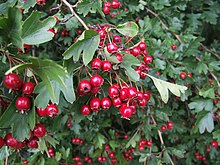Oosthoekduinen


The Oosthoekduinen (Eng .: Osteck dunes) are in the narrower sense a 38 hectare large dune area and dune forest area directly south of De Panne , the westernmost municipality on the Belgian North Sea coast .
In a broader sense, the area also includes 20 hectares of dune fringes in the southeast of the dune, in which the sandy dune landscape merges into the fertile polder area and in the west a sub-area of 20 hectares of the Calmeynbos dune forest (German Calmeyn forest), more precisely the forest area west of the Kerkstraat, which cuts through the Calmeynbos and leads from De Panne to Adinkerke .
The total area of approx. 80 hectares forms a bridge from the nature reserve De Westhoek , which extends in the west to the French border and continues there geologically in the Dune du Perroquet , to the 80 hectare Houtsaegerduinen in the northeast. The latter are separated from the Oosthoekduinen by built-up areas.
Geology and biology
The dunes have been around for a few hundred years, so that part of the lime that mixed the sand when the dunes formed as shell gravel was dissolved by carbonic acid in the copious North Sea rain and is now washed out.
Moss dunes and dune pastures
Within the Oosthoekduinen the moss dunes and pastures are by rotary tooth mosses and dwarf plants, such as Saxifraga Tridactylites , Sharp Mauerpfeffer and lichen covered. The slight decalcification is visible through the settlement of plants such as beaver-nell rose , thyme , dune pansy , mountain sand bells , silver grass and various reindeer lichens . Typical animal species in this area are mother-of-pearl butterflies and the blue-winged wasteland insect .
Dune bushes
The species and genera that are typical of the North Sea region such as blackthorn , eucoat , hawthorn and privet can be found in the dune bushes . Typical bird species there are blackcap , nightingale , blackcap and fitis .
Dune forest
The dune forest has a rich vegetation elm: field elm , mountain elm , Dutch elm , and Ulmus laevis .
Dune fringes
In the area of the dune fringes, the transition from the sandy soil of the dunes to the loamy , fertile soil of the polder, where ferrous groundwater also ensures fertility, there are many types of willow and flowering plants.
Groundwater pools and drainage ditches provide a habitat for water-loving plants, marsh plants and aquatic plants . Rare amphibians such as crested newt and natterjack toad also live here.
De Nachtegaal visitor center
The visitor and nature education center De Nachtegaal was built between Calmyenbos and the Oosthoekduinen, explaining the entire geological and biological system of the North Sea coast and dunes. From there a circular hiking trail leads through the Oosthoekduinen.
natural reserve
The Flemish Agency for Nature and Forests started the nature development project "Oosthoekduinen" in 1999. The project included the Oosthoekduinen, the Oosthoek transition zone and the dune forest.
Trees not belonging to the area, mainly Mahonia , were felled and new ponds were dug. A dilapidated military area has been renatured and placed under protection: An old bunker, for example, now serves as accommodation for bats. In order to preserve the open parts of the landscape, pastures were created for sheep, cattle and Konik horses. The measures were completed in spring 2005.
The Agency for Nature and Forests is permanently responsible for the administration, conservation and improvement of the area.
literature
Web links
- Hiking in the Oesthoekduinen at routeyou.com
- De Panne's website on Oosthoekduinen
- Aerial photo with the border of the narrow dune area at be.geoview.info. The forest to the west and the grassland of the dune fringes in the southeast are also clearly visible.
swell
- Agentschaap voor Natur en Boos ( German Agency for Nature and Forests ) (Ed.): Welcome to the Oosthoekduinen. A German-language brochure about the area with a map , which was displayed in 2014 in the visitor and nature education center De Nachtegaal .
Individual evidence
- ↑ http://www.natuurenbos.be/nl-BE/domeinen/west-vlaanderen/oosthoekduinen
- ↑ Agentschaap voor Natur en Boos (German Agency for Nature and Forests) [Ed.]: Welcome to the Oosthoekduinen . Section Valuable Moss Dunes and Pastures
- ↑ Agentschaap voor Natur en Boos (German Agency for Nature and Forests) [Ed.]: Welcome to the Oosthoekduinen . Section At the transition from dune to polder
- ↑ http://www.natuurenbos.be/nl-BE/domeinen/west-vlaanderen/oosthoekduinen/beheer

